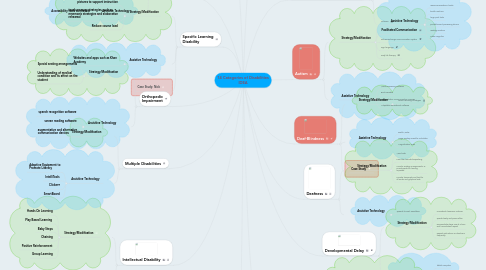
1. Hearing Impairment
1.1. Strategy/Modification
1.1.1. visual presentations
1.1.2. alternate between discussion and reading/activity time
1.1.3. Be careful not to obscure your mouth when speaking
1.2. Assisitive Technology
1.2.1. Speech-to-Text Translation tools
1.2.2. Hearing loop System
1.2.3. FM systems
1.2.4. Personal amplifiers
2. Intellectual Disability
2.1. Strategy/Modification
2.1.1. Hands On Learning
2.1.2. Play Based Learning
2.1.3. Baby Steps
2.1.4. Chaining
2.1.5. Positive Reinforcement
2.1.6. Group Learning
2.2. Assisitive Technology
2.2.1. Computer
2.2.2. Word Processor
3. Multiple Disabilities
3.1. Strategy/Modification
3.2. Assisitive Technology
3.2.1. Adaptive Equipment to Promote Literacy
3.2.2. IntelliTools
3.2.3. Clicker5
3.2.4. SmartBoard
4. Orthopedic Impairment
4.1. Strategy/Modification
4.1.1. Special seating arrangements
4.1.2. Understanding of medical condition and its affect on the student
4.2. Assisitive Technology
4.2.1. speech recognition software
4.2.2. screen reading software
4.2.3. augmentative and alternative communication devices
5. Other Health Impairment
5.1. Strategy/Modification
5.1.1. Extra Transition Time
5.1.2. Simplified steps
5.1.3. Reduced Workload
5.2. Assistive Technology
5.2.1. Accessibility tools as needed
6. Specific Learning Disability
6.1. Strategy/Modification
6.1.1. Use diagrams, graphics and pictures to support instruction
6.1.2. teach memory strategies, such as mnemonic strategies and elaborative rehearsal
6.1.3. Reduce course load
6.2. Assistive Technology
6.2.1. Websites and apps such as Khan Academy
6.3. Case Study: Nick
7. Speech or Language Impairment
7.1. Assistive Technology
7.1.1. Specialized audio/visual software to aid and supplement classroom learning
7.2. Strategy/Modification
7.2.1. Interactive communication
7.2.2. Multimodal instruction and activities
7.2.3. Team activities with specific duties
8. Autism
8.1. Strategy/Modification
8.1.1. Inclusion
8.1.2. Facilitated Communication
8.1.3. Picture Exchange Communication System
8.1.4. Sign language
8.1.5. Daily life therapy
8.2. Assistive Technology
8.2.1. Word Processing Software
8.2.2. Book Readers
8.2.3. Augmentative Communication Devices
8.2.4. Adaptable Educational Software
9. Deaf-Blindness
9.1. Strategy/Modification
9.1.1. Tactile Learning Strategies
9.2. Assistive Technology
9.2.1. Braille Writer
9.2.2. Large Display Scientific Calculator
9.2.3. Magnification Tools
9.3. Case Study
10. Deafness
10.1. Strategy/Modification
10.1.1. Visual aids
10.1.2. Face the class while speaking
10.1.3. Circular seating arrangements, or priority seats for hearing impaired
10.1.4. Provide transcripts and text for all audio and graphical aids
10.2. Assistive Technology
10.2.1. Speech-to-Text Translation
11. Developmental Delay
11.1. Strategy/Modification
11.1.1. Consistent classroom routines
11.1.2. Speak slowly and pause often
11.1.3. Demonstrate steps one at a time and have student repeat
11.1.4. Repeat instructions or directions frequently
11.2. Assistive Technology
11.2.1. tablet computer
11.2.2. PowerPoint
11.2.3. Audiobooks
12. Emotional Disturbance
12.1. Strategy/Modification
12.1.1. Support the student’s inclusion
12.1.2. Set clear behavioral rules and expectations
12.1.3. Recognize the student's accomplishments
12.2. Assistive Technology
13. Traumatic Brain Injury
13.1. Strategy/Modification
13.1.1. Direct Instruction
13.1.2. Assign a "peer buddy" to assist
13.1.3. Modified workload and expectations
13.2. Assistive Technology
13.2.1. Augmentative comunication devices
13.3. Case Study: Josh
14. Visual Impairment Including Blindness
14.1. Strategy/Modification
14.1.1. lecture information in a visual format
14.1.2. Give verbal description of visual aids
14.1.3. take care over seating arrangements and encourage people to take turns to speak
14.2. Assistive Technology
14.2.1. resources avaiabe in braile
14.2.2. braille machine
14.2.3. large print texts
14.2.4. portable word processing device
14.2.5. reading machine
14.2.6. video magnifier

